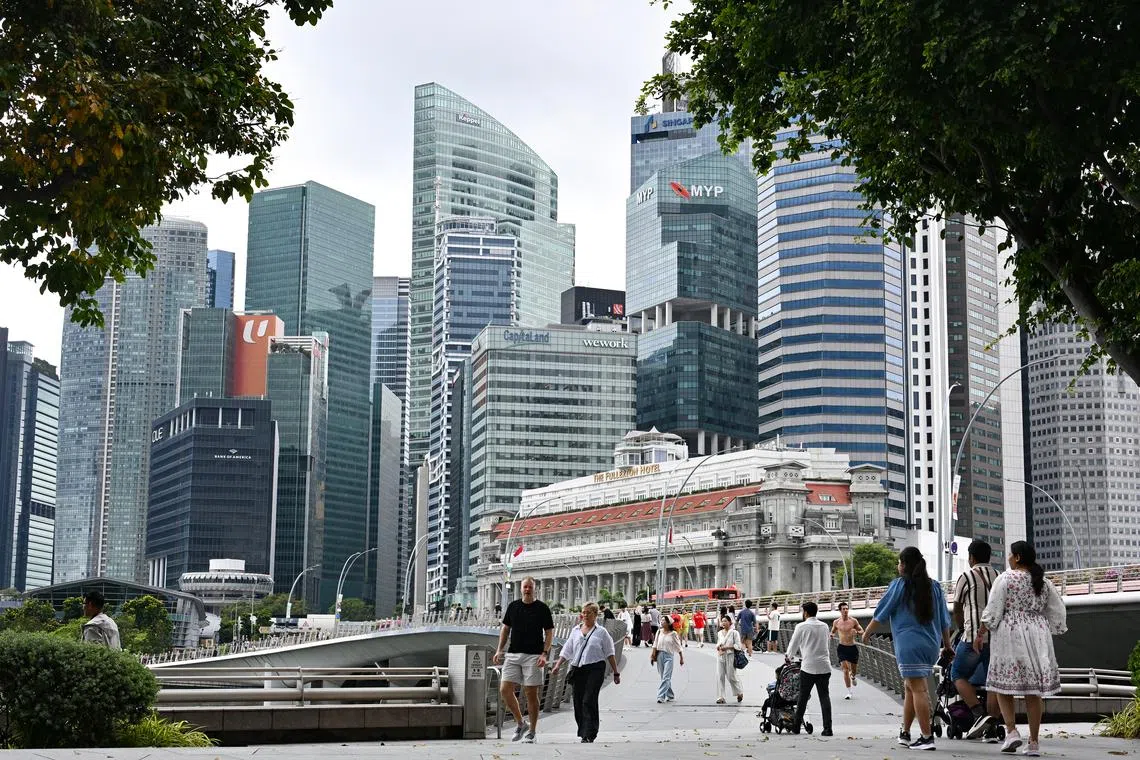Better than feared: S’pore growth forecast raised to 2.4% for 2025; slower growth expected in 2026
Sign up now: Get ST's newsletters delivered to your inbox

Economists see Singapore’s growth slowing to 1.9 per cent in 2026, according to a MAS survey.
PHOTO: ST FILE
Follow topic:
Singapore – Private sector economists raised their forecast for Singapore’s economic growth in 2025, citing milder-than-expected trade tensions, but they also see the possible levying of semiconductor and pharmaceutical tariffs by the US as the biggest threat to the outlook.
Singapore’s gross domestic product (GDP) is projected to expand 2.4 per cent in 2025, according to the latest quarterly survey of professional forecasters by the Monetary Authority of Singapore (MAS) released on Sept 3. This is higher than the previous survey estimate of 1.7 per cent made in June.
The latest growth forecast is underpinned by the improved outlook for manufacturing, construction, wholesale and retail trade, and key exports. In contrast, the growth forecast for accommodation and food services fell to 0.5 per cent from an already weak 1.5 per cent in the June survey.
The upgrade comes after the economy’s surprisingly strong performance in the first half of the year, leading the Government to raise its growth forecast for 2025.
The economists, however, see Singapore’s growth slowing to 1.9 per cent in 2026, according to the MAS survey.
Their latest growth projection for 2025 is still slower than the 4.4 per cent expansion seen in 2024.
But it is at the higher end of the 1.5 per cent to 2.5 per cent range projected by the Ministry of Trade and Industry (MTI) in August, after it raised its forecast from an earlier range of 0 per cent to 2 per cent growth.
Geopolitical tensions, including the introduction of semiconductor and pharmaceutical tariffs, have emerged as the foremost downside risk to Singapore’s economic outlook.
US President Donald Trump said in August that the US could initially place a “small tariff” on pharmaceutical imports, before hiking tariffs to 150 per cent within 18 months and eventually to 250 per cent in an effort to boost domestic production. He did not specify the initial tariff rate.
He also said he plans to announce tariffs on semiconductors and chips, but gave no further details.
External slowdown and financial market volatility were also cited as potential downside risks by economists in the survey.
Milder-than-expected or easing of trade tensions was the most frequently cited upside risk – or factor that could raise the outlook – along with a sustained tech cycle upturn and capital inflows into Singapore.
The Singapore economy grew 4.4 per cent year on year in the second quarter of 2025 – when economists in the June survey had tipped second-quarter growth of 3 per cent.
The economists now expect growth to fall to 0.9 per cent in the third quarter of 2025.
DBS economist Chua Han Teng said: “This marks a notable deceleration from the strong 4-plus per cent expansion recorded in both the first half of 2025 and 2024.”
But he said the construction sector remains a bright spot, as it benefits from multi-year projects to enhance Singapore’s competitiveness in trade, transport and tourism, as well as public housing building activities.
Economists’ median forecast for overall inflation in 2025 is 0.9 per cent, unchanged from the June survey. The forecast for core inflation is 0.7 per cent, slightly lower than 0.8 per cent in the previous survey.
As for the labour market, economists expect the unemployment rate to be 2.2 per cent at the year end, unchanged from the June survey.
Mr Euben Paracuelles, Nomura’s chief Asean economist, does not see Singapore slipping into a recession even after factoring in a slowdown in the second half of 2025 due to tariff-related impact.
“We still believe large fiscal space will be used by the Government to provide more support measures, particularly on preserving jobs, helping provide a significant offset to weaker export growth,” said Mr Paracuelles, who revised his 2025 GDP forecast to 2.6 per cent in mid-July.
He is forecasting the jobless rate to rise moderately to around 2.4 per cent in 2026, from 2.2 per cent in 2025.
“Prime Minister Lawrence Wong’s speech, which indicated a strong focus on ‘jobs, jobs, jobs’, is very encouraging and quite appropriate, in our view,” he said.
Dr Chua Hak Bin, a Maybank economist, said the projected unemployment rate has been held steady at 2.2 per cent because of expectations that the Government will step up incentives for companies to hire. These include traineeships for fresh graduates.
“Growth has been relatively resilient, and manpower surveys still suggest some net hiring despite the uncertain global outlook,” he told The Straits Times.
He, too, does not see Singapore entering a recession if the US imposes tariffs on chips and pharmaceuticals.
Dr Chua said the threatened tariffs on semiconductors will be exempted for companies investing in and expanding manufacturing capacity in the US. “Many of the large chip players in Singapore, including Micron, Intel and GlobalFoundries, are investing in new plants in the US and should be exempted from the chip tariffs,” he said.
He expects GDP growth of 3.2 per cent for Singapore in 2025 – a level well above MTI’s forecast range.
The economic growth could be stronger in the light of the better-than-expected manufacturing surge in July, Dr Chua said.
He added that the September purchasing managers’ index
Slightly more than 40 per cent of the economists expect MAS to ease its Singapore dollar policy at the next review in October.
Easing can lower the rate of appreciation of the Singapore dollar, helping to make exports more competitive. A tightening move, on the other hand, can strengthen the Singapore dollar to help counter imported inflation.
MAS kept policy unchanged at its last review in July
Almost all the respondents expect no monetary policy shift in the January 2026 policy review.


